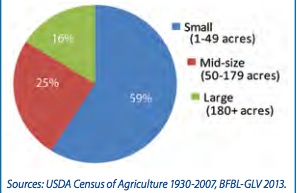According to the One Lehigh Valley Local Food Economy Report – The biggest barrier to fostering a more robust local food economy is continued loss of farmland.

130+ acre working farm in Lower Macungie. If the township doesn’t get proactive in preservation this will be 300 units someday.
Important to note since often overlooked: Agriculture IS a form of industrial infrastructure. Yet communities continue to pave over this invaluable asset only to replace it with uses that require additional infrastructure and strain local resources to sustain. Farmland is fiscally one of the highest value land uses in terms of liabilities vs. revenue.
- Since 1930 the LV has lost 80% of it’s farms. Based on average diets Lehigh Valley farmers can only produce about 20% of the Valley’s food demands. With a market shift towards locally grown foods there is clearly money to be made in both local and regional economies.
All it takes are strategic investments in “food infrastructure” needed to support a local food economy. For ex: Aggregators, distributors, food business incubators, grain mills, and more food hubs. Even underserved and undervalued we already today have a local food economy that contributes 17 million annually to the LV economy.
900,000 residents with 145,000 more on the way. We have restaurants today who seek local sourced food. We have a network of municipal farmers markets. Eight Lehigh Valley areas today have limited access to fresh foods. *Super-majorities of residents value preserving farmland. Yet as a matter of mis-guided policy localities encourage the loss of the agriculture infrastructure. We have the will, there is demand, our economies will benefit. The economics make sense. What exactly is the holdup? Let’s acknowledge this as a regional opportunity!
What I can’t help but think is which forward thinking local municipality is going to recognize this and jump on it? A tenet of smart growth is utilizing existing infrastructure. Remaining farmland in our outer ring suburbs is just that. Who will make these connections and reconcile it with a communities desire to protect farmland and the corollary quality of life benefits. Which community will take the ball and run with it? Yes, it’ll take some time and a little more work vs. turning over a greenfield to a developer. And the benefits won’t be as immediate as one time cash infusions of a major real estate transfer. But over time it’s a move to set a community up for the long term. It’s the long play. The smart play.
For a community like Lower Macungie despite the continued loss of much of our land including 700 acres in 2010 the opportunity is still not lost. A local food economy thrives on small farms > 40 acres. These are the operations that grow the food we eat and we still have many parcels that fit that criteria. It’s incorrect to assume that only large contiguous acreage is worth preserving. The alternative is to pave them. If we choose that route we should be prepared to pay the long term price.
 * Lower Macungie Parks and Recreation Comprehensive plan: 60% of respondents to public survey component rank acquiring and protection of open space as “extremely important” in a ranking of priorities. (the highest ranking)
* Lower Macungie Parks and Recreation Comprehensive plan: 60% of respondents to public survey component rank acquiring and protection of open space as “extremely important” in a ranking of priorities. (the highest ranking)
